This Week's Show
This Week’s Show
November 14, 2025
listen / download
Energy Powers Democratic Wins
listen / download
November’s elections brought victories across the country for state and local Democratic candidates who pledged to address rising energy costs. The challenges of meeting those promises the incoming Governors of Virginia and New Jersey, and Mayor of New York, will likely face.
UN Climate Ambition Gap
listen / download
The 30th UN climate talks are underway in Belém, the “gateway to the Amazon” in Brazil, but national pledges are still way off track from what's needed to halt the quickening pace of global warming. We discuss efforts to close that gap, and the power of the talks to focus minds on the emerging reckoning.
Earth's Cryosphere On Thin Ice
listen / download
Scientists attending the UN climate talks in Brazil are highlighting the alarming state of the cryosphere, or the frozen part of Earth covered in ice, snow, and permafrost. A recent report warns that the European Alps, Rockies of the Western U.S. and Canada, Iceland, and Scandinavia would lose nearly all ice at 2°Celsius of warming – a threshold we’re currently on track to exceed.
Rights of Nature for Stingless Bees
listen / download
In the Peruvian Amazon, the Asháninka people have developed a symbiotic relationship with the local bees, which often lack stingers, and their honey. As habitat loss linked to climate change, forest fires, and deforestation threatens these pollinators and honey makers, a new and innovative law in Peru has granted these bees legal rights to help protect them and the indigenous people living with them.
Air Date: November 14, 2025
FULL SHOW
SEGMENTS

Energy Powers Democratic Wins
/ Aynsley O’Neill and Paloma BeltranView the page for this story
November’s elections brought victories across the country for state and local Democratic candidates who pledged to address rising energy costs. Marianne Lavelle, Washington bureau chief for our media partner, Inside Climate News, joins Hosts Aynsley O’Neill and Paloma Beltran to talk about the challenges of meeting those promises the new Governors-elect of Virginia and New Jersey, and the newly elected Mayor of New York, will likely face. (12:18)
UN Climate Ambition Gap
View the page for this story
The 30th UN climate talks are underway in Belém, the “gateway to the Amazon” in Brazil, but national pledges are still way off track from what's needed to halt the quickening pace of global warming. Longtime climate talk observer and Senior Associate for E3G Alden Meyer is at COP30 and talks with Host Paloma Beltran about efforts to close that gap and the power of the talks to focus minds on the emerging reckoning. (14:54)
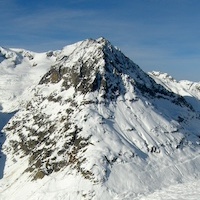
Earth's Cryosphere On Thin Ice
View the page for this story
Scientists attending the UN climate talks in Brazil are highlighting the alarming state of the cryosphere, or the frozen part of Earth covered in ice, snow, and permafrost. A recent report warns that the European Alps, Rockies of the Western U.S. and Canada, Iceland, and Scandinavia would lose nearly all ice at 2°Celsius of warming – a threshold we’re currently on track to exceed. Glaciologist and climate scientist Miriam Jackson is the Eurasia and Nordic director of the International Cryosphere Climate Initiative and joins Host Paloma Beltran to explain how the perilous state of glaciers endangers human civilization as the Earth warms. (07:34)

Rights of Nature for Stingless Bees
View the page for this story
In the Peruvian Amazon, the Asháninka people have developed a symbiotic relationship with the local bees, which often lack stingers, and their honey. As habitat loss linked to climate change, forest fires, and deforestation threatens these pollinators and honey makers, a new and innovative law in Peru has granted these bees legal rights to help protect them and the indigenous people living with them. Reporter Teresa Tomassoni of our media partner Inside Climate News speaks with Host Aynsley O’Neill about the remarkable relationship between these bees and people. (11:50)
Show Credits and Funders
Show Transcript
251114 Transcript
HOSTS: Paloma Beltran, Aynsley O’Neill
GUESTS: Miriam Jackson, Marianne Lavelle, Alden Meyer, Teresa Tomassoni
[THEME]
O’NEILL: From PRX – this is Living on Earth.
[THEME]
O’NEILL: I’m Aynsley O’Neill
BELTRAN: And I’m Paloma Beltran
World leaders gather in Brazil for the 30th UN conference on climate.
MEYER: The COPs and the negotiations are basically a mirror that we hold up to ourselves each year to reflect how we're doing as a species in dealing with this unprecedented emergency. And if the image that we see in the mirror appears a little ugly, it doesn't do a lot of good to blame the mirror.
O’NEILL: Also, legal protections for an Amazonian insect with strong cultural ties.
TOMASSONI: For thousands of years, they say their ancestors have relied on the bees to provide honey that helps them treat a variety of illnesses. The indigenous peoples really credit the stingless bees for helping them survive.
O’NEILL: That and more, this week on Living on Earth. Stick around!
[NEWSBREAK MUSIC: Boards Of Canada “Zoetrope” from “In A Beautiful Place Out In The Country” (Warp Records 2000)]
[THEME]
Energy Powers Democratic Wins
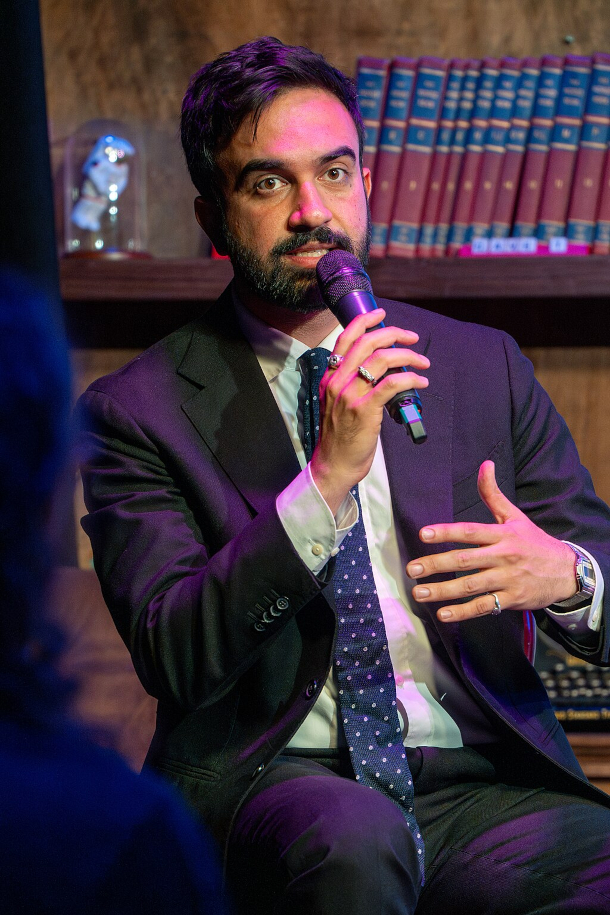
New York City’s Mayor-elect Zohran Mamdani (D) frames the climate and affordability crises as intimately connected. (Photo: Bryan Berlin, Wikimedia Commons, CC BY-SA 4.0)
BELTRAN: From PRX and the Jennifer and Ted Stanley studios at the University of Massachusetts Boston, this is Living on Earth. I’m Paloma Beltran.
O’NEILL: And I’m Aynsley O’Neill.
Paloma, I don’t need to tell you that there has been a lot of legislative and funding chaos in Washington DC recently, to put it mildly, and Democrats are struggling to retain some grip on political power during the Trump presidency and with Republicans at the reins in Congress.
BELTRAN: That’s right, Aynsley, and with all that division and infighting in Washington sucking up much of the political air, it can be easy to forget about the impact of local politics. But of course, what happens at the local and state level can make a huge difference, especially in the long run and when it comes to environmental issues.
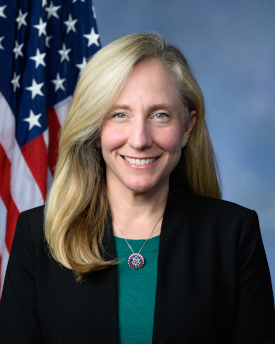
Governor-elect Abigail Spanberger (D) of Virginia, along with the state’s Democratic-led House of Delegates, will face tough decisions around proposals for data center expansion across the state. (Photo: U.S. House of Representatives, Wikimedia Commons, Public domain)
O’NEILL: Well November’s elections did bring notable victories and a sigh of relief for Democrats across the country, boosting the party’s optimism and generating questions about its future direction.
BELTRAN: Now environmentalists are wondering to what extent addressing the climate crisis will be part of that future.
O’NEILL: Here to talk to us about what to keep an eye on as these new leaders step into action is Marianne Lavelle, Washington bureau chief for our media partner, Inside Climate News. Welcome back to Living on Earth, Marianne!
LAVELLE: Great to be here.
O'NEILL: So perhaps the result that got the most attention was the victory of 34-year-old Democratic Socialist Zohran Mamdani as the next mayor of New York City.
BELTRAN: Yeah, his campaign, which focused a lot on affordability for average New Yorkers, seemed to strike a positive chord, especially with young progressives.
O'NEILL: But something that may or may not have gotten a little lost in the shuffle were his stances on climate issues. Marianne, how has Mamdani framed the climate crisis?
LAVELLE: Yes, I think it may have gotten lost because he didn't talk about it directly, but in the context of this greater affordability message, he would say when asked about it, climate and quality of life are not two separate concerns. They're one and the same. And I think the best example of how he framed the issue is he had this “Green Schools for a Healthier New York City” proposal. He wants a massive program of upgrading 500 schools. And this is a very popular idea, because everyone knows that those schools really need upgrades. And if they can upgrade the school buildings while improving energy systems and even adding solar and replace asphalt with green school yards, it could reduce costs as well as improving the schools, which is something that's long been needed. So it's kind of the win-win solution on climate and quality of life that he liked to talk about.
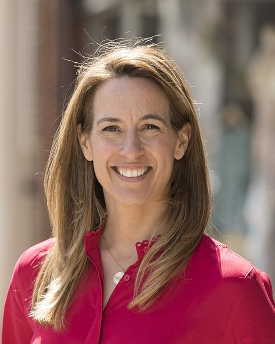
New Jersey’s Governor-elect Mikie Sherrill (D) has promised a utility rate freeze on her first day in office. (Photo: Joeshmonobody, Wikimedia Commons, CC BY-SA 4.0)
O'NEILL: And so now he's got a four-year term coming up. What will be the biggest challenges for a New York City mayor to deal with when it comes to climate?
LAVELLE: There's no question that it's going to be all of those big buildings in New York City. The city actually in 2019, passed a law, one of the world's most ambitious city laws to reduce greenhouse gas emissions, and 70% of those emissions come from big buildings. The landowners say this is going to be way too expensive for us. We're going to have to invest millions of dollars in these upgrades, and the current mayor, Eric Adams, had been working to ease the requirements for the real estate industry. What Mamdani has said is he's going to enforce the law, but he's going to find ways to make it affordable, to help the landlords pay for those upgrades. So he's going to use some existing programs to really give them, kind of a one stop shop for help on doing this. Tax breaks certainly could be a big part of that. That is an area where he's going to have this tension between affordability and climate goals.
BELTRAN: So where else might he encounter some tension between this push for affordability and development?
LAVELLE: Well, the natural gas industry is going to be wanting to build more pipelines and plants in New York and they argue that this is to make energy affordable and reliable. And right now, there's a big pipeline project that the governor approved just this week, and it's going to continue to be a big issue for New York City because it goes right by Staten Island and Rockaway Peninsula. The mayor is certainly going to be pulled into the debate over that infrastructure, and he says he doesn't want to see more natural gas infrastructure. The industry, meanwhile, will be saying, well, we're the industry that's going to make energy affordable.

Peter Hubbard (D) was one of the Democrats elected to the Georgia Public Service Commission. It was the first time Democrats were elected to statewide office since 2006. (Photo: TwiceBakedBean, Wikimedia Commons, CC BY-SA 4.0)
BELTRAN: Sounds like he has his work cut out for him.
LAVELLE: He really does, and he's going to be watched closely, because other cities around the country and really around the world, they want to see if they can set similar goals on climate and really make them happen.
O'NEILL: Well, there were a number of elections in other states and municipalities, and so what other leaders who were elected should we be paying attention to, Marianne?
LAVELLE: Well, I definitely have an eye on Abigail Spanberger. She's the former Democratic member of Congress from Virginia who was just elected Virginia's new governor.
BELTRAN: And from what I understand, she will be the first female governor of the state, right?
LAVELLE: That's right. And Democrats also flipped 13 seats in their legislature, giving them a really solid majority in the state's House of Delegates.
BELTRAN: Wow. Well, what does this new balance of power mean for environmental policies in the state?
LAVELLE: For both Governor Spanberger and the legislature, there's going to be urgent, tough issues on a massive amount of new data center proposals, these big data centers that are necessary for artificial intelligence. Right now, Virginia is the number one state in data center capacity. Northern Virginia is actually the number one market in the world. Only Beijing is second for these big data centers. And there are proposals out there to add four times the current capacity.
O'NEILL: And now Marianne remind us why these data centers are a cause for so much environmental concern?
LAVELLE: Well, there's a lot of questions, including the footprint of the centers and also their water use, but probably the biggest questions have to do with their huge energy use. In 2020 Virginia's Clean Economy Act was passed, and that was meant to decarbonize the state's electric grid by 2050 but how can the state reduce its fossil energy as the law calls for when it's seeing all this new demand from the data centers?
O'NEILL: Well, I know Spanberger's platform included talk about lowering energy costs and producing more energy in Virginia. How did she propose to do that?
LAVELLE: She'd like to see a big build out of solar and battery storage in Virginia, and she's also a big proponent of offshore wind, but all of the offshore wind projects require federal approvals, and she's going to face opposition from the Trump administration on that. There could be a similar situation like we've seen in New York, where the President pressures the governor to get concessions and agree to natural gas build out in return for his approval of wind projects. So that's definitely a thing to watch for.
O'NEILL: All right, well, Marianne, as many of our listeners know, I am a proud Jersey girl, and we just elected a new governor, Democrat Mikie Sherrill. What promises has she made along the lines of energy?
LAVELLE: Well, she promises to put a freeze on utility rates on her first day in office, and then begin a massive build out of new electricity sources. New Jersey has had one of the highest run ups in electricity bills in the country, up about 20% in one year, and she said, we need more power, and we need to know more about how the utility companies are using this money.
BELTRAN: And to what extent is Governor-elect Sherrill proposing renewable energy expansion?
LAVELLE: She definitely wants to see solar and battery power to be a big emphasis. She also is a proponent of offshore wind. Her opponent was going to put a ban on offshore wind. So that's a big difference that New Jersey voters voted for. There still is going to be pressure to expand natural gas, just as in the other states. New Jersey has a lot of nuclear power, and she wants to build on that, and she said that also is a way to expand energy and keep carbon emissions down.

Marianne Lavelle is the Washington Bureau Chief for our media partner, Inside Climate News. (Photo: Courtesy of Marianne Lavelle)
BELTRAN: Yeah, and Marianne, I also heard that the Georgia Public Service Commission election was somewhat of a shock, with Democrats Peter Hubbard and Alicia Johnson securing two seats on the Commission. What was going on there, do you think?
LAVELLE: Absolutely, it was a big deal. And the Georgia Public Service Commission, not many people usually keep track of that office, but it's a big office for deciding utility rates, and people were pretty fed up with a whole bunch of increases in their electricity bills. So the same issue that we've seen in New Jersey, in Virginia, in New York: energy affordability.
O'NEILL: Yeah, that really seems to be sort of a common theme out there, Marianne. What else have you seen across these various different political landscapes when it comes to climate?
LAVELLE: Well, one thing that I think you're going to hear throughout the coming year is tying these rising energy and electricity rates to the Trump administration policies. We've had electricity rates increasing even before Trump took office, but things like shutting down offshore wind, forcing old coal plants to run even though they're problematic. You're going to hear opponents of the Republicans be bringing this up over and over again, that clean energy is cheaper energy, and that is really going to be a theme in these political races in the coming years that could help decide control of Congress.
O'NEILL: We will definitely have to keep tabs on these new leaders and new policies on the road to midterms just one year away.
LAVELLE: Absolutely.
BELTRAN: Marianne Lavelle is the Washington bureau chief for our media partner Inside Climate News. Thanks so much for taking the time with us, Marianne.
O'NEILL: Thank you, Marianne.
LAVELLE: Thanks for having me.
Related links:
- Inside Climate News | “Green Groups’ Election Takeaway: Focus on Trump Energy Agenda Costs”
- Inside Climate News | “New York Climate Advocates Celebrate Mamdani’s Victory, Prepare to Hold Him Accountable”
- Inside Climate News | “With a Lock on State Government Control, Virginia Democrats Now Face Difficult Decisions on Data Centers and Renewable Energy”
[MUSIC: Eddie Higgins, “Falling in Love with Love” on Eddie Higgins, Amanita]
BELTRAN: Coming up, an update on global climate policy and science as COP30 kicks off. That’s just ahead on Living on Earth. Stay tuned!
ANNOUNCER: Support for Living on Earth comes from the Waverley Street Foundation, working to cultivate a healing planet with community-led programs for better food, healthy farmlands, and smarter building, energy and businesses.
[CUTAWAY MUSIC: Eddie Higgins, “Falling in Love with Love” on Eddie Higgins, Amanita]
UN Climate Ambition Gap
This year’s COP is being held in Brazil, a country whose famous rainforests are plagued by deforestation. (Photo: Courtesy of Miriam Jackson)
O’NEILL: It’s Living on Earth, I’m Aynsley O’Neill.
BELTRAN: And I’m Paloma Beltran.
This year’s UN climate talks are underway in Belém, the “gateway to the Amazon” in Brazil. And with nations’ pledges to reduce greenhouse gas emissions way off track from where they need to be to meet key climate goals, frustrations have boiled over.
[SOUNDS OF PROTEST]
BELTRAN: On the second day of COP30, protesters led by Indigenous peoples including the Tupinambá diverted from a government-approved protest route and stormed past security into the COP30 venue.
[SOUNDS OF PROTEST]
BELTRAN: An Indigenous leader identified by the Guardian as Cacique Gilson wore a blue feathered headdress and spoke during the protest.
[INDIGENOUS MAN SPEAKING]
VOICEOVER: We don’t eat money. We want our territory free. But the business of oil exploration, mineral exploration, and logging continues.
BELTRAN: Longtime climate talk observer and Senior Associate for E3G Alden Meyer is there at this COP and witnessed some of the commotion.
MEYER: I think it just shows you know that you can't keep the outside concerns and passions of people from affecting the process here. This was a particularly dramatic way of doing that, and just a symbol of how much the outcome of these talks means to people because they see how it's directly affecting their lives.
At this year’s COP, countries are negotiating a wide range of issues reflecting often competing interests. (Photo: Courtesy of Miriam Jackson)
BELTRAN: Indigenous communities play crucial roles in protecting ecosystems around the world. Brazil is establishing an initiative called the Ethical Stocktake to call attention to the disproportionate effect that the climate crisis is having on marginalized communities, including Indigenous people. How could this shape COPs going forward?
MEYER: Well, it's a very interesting process. It's been led by Marina Silva, the Environment Minister of Brazil, as well as her counterpart, the Indigenous Minister of Brazil, has been very engaged in this, Sônia Guajajara, and they have held a number of dialogues and meetings around the world in this Ethical Stocktake process, engaging not just Indigenous communities, but scientists, artists, poets, ethicists, people from all walks of life, to try to say, what is our moral responsibility to impacted people, to future generations, to achieve the kind of outcomes we need in this process? They have provided an input to this process. It's not a negotiated input. It was developed based on the consultations they had around the world over the last year or so. But it really is a voice for morality and ethics and the rights of impacted people, both now and in the future, and I think it is making a difference in the way that they're perceived. Brazil also, the presidency has made an unprecedented effort to engage Indigenous communities and people in this process in terms of observer status, participation in dialogues, et cetera. You know, it's still not enough. It's not everything the Indigenous people constituency in this process would like to see, but I think it is a step forward, and I think it's going to be pretty hard for future COP presidencies to try to roll that back and do less to reflect the interests of those communities in this process.
Sonia Guajajara leads the Ministry of Indigenous Peoples in Brazil. She worked on the Global Ethical Stocktake, an initiative to prioritize the needs of marginalized people in the fight against climate change. (Photo: Valter Campanato, Agência Brasil, Wikimedia Commons, Public Domain)
BELTRAN: So COP is being hosted in Brazil this year, which is an interesting dynamic. On the one hand, Brazil has made efforts to preserve its rainforest ecosystem, but deforestation continues, and the nation is also exploring the possibility of drilling for oil in the Amazon region. How is Brazil navigating its place at this year's climate talks?
MEYER: Well, this is a sort of inherent contradiction in a lot of countries, including some of the most recent hosts of the COPs. On the one hand, you're seeing a long-term commitment to transitioning away from fossil fuels. We have to get to net zero emissions by mid-century. That's not that far away anymore. On the other hand, you see short term economic development and energy security imperatives which are driving not just Brazil, but many other countries to continue to develop and produce oil, coal and gas, despite their long-term commitments to phasing out those energy sources. And of course, here in Brazil, it's not just oil drilling. You see dramatic expansion of beef production, of soybean production, which are putting strains on the rain forest, on the Amazon. This is true in other countries as well. I think the US is the leading developer and exporter now of fossil fuels and in terms of projected development, particularly around liquefied natural gas. You also see that with other producing countries in the north, like the UK and Norway and Canada and Australia. And of course, you're seeing countries in Africa and elsewhere moving to exploit their fossil fuel resources. So this is sort of an inherent contradiction. We're trying to manage a transition away from what has powered the Industrial Revolution and fired up economies over the last century, and we're trying to do it in an unprecedentedly rate of speed and short amount of time to make that transition. So, there are strains and contradictions in the system. I don't think it has impacted the ability of the Brazilian presidency and their very experienced team of diplomats to manage this process. They're doing a very skillful job. But just like any other country, there are different forces at play, and there are very powerful interests in Brazil, in the energy sector, in the agriculture sector, in the mining sector, that don't want to change the current rules and ways of doing business because that would impact their business models and their profitability.
BELTRAN: And, Alden, I do want to ask you, what's been the presence of the fossil fuel industry at this year's climate talks?
MEYER: Well, the fossil fuel industry has been in this process since the very beginning. They are definitely here in force. They are represented both in terms of investor-owned companies like the big petro chemical companies and oil producers and coal producers, but of course, they're also represented by many of the state owned companies that produce coal, oil and gas and the exporting countries, particularly the Arab region, but others, so they are definitely present. There is going to be a big fight over how specific we can get on implementing the consensus decision from two years ago on the need to transition away from fossil fuels in the energy sector. At that decision in Dubai, at COP 28, we were able to get specific commitments to triple production of renewable energy by 2030 and to double the rate of energy efficiency improvement from around 2% a year to 4% a year by 2030, but we were not able to get any benchmarks or quantification of the transition away from fossil fuels. So there are discussions here about the need to set up a process and a roadmap forward on how to implement that decision. Brazil is talking with people about that. Colombia has put forward a proposal on this. Other countries are talking about it. But the more specific you get on that, the more vociferous the opposition will be from both the privately owned companies and the oil, gas and coal producing countries. So talk to me after the end of next week, and we'll see what we get out of here. But this is definitely going to be a very live issue over the next 10 or 12 days.
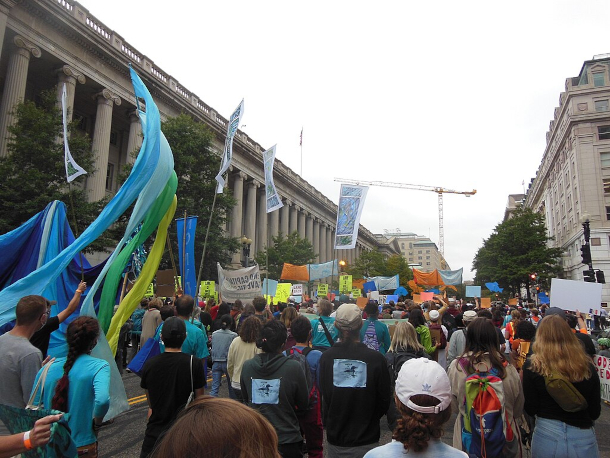
Meyer says that the COP process is a mirror to what happens in each individual country. He believes that, in order to make change, people must make their interests known in their home countries. (Photo: Frypie, Wikimedia Commons, CC BY-SA 4.0)
BELTRAN: Decade after decade, countries have promised to address the climate crisis, but scientists say that limiting global temperature rise to 1.5 degrees Celsius will be impossible without urgent action. What signs do you see that countries might bridge the gap between motivation and action?
MEYER: Well, let me first talk about the science, because I think we have seen a shift here. Even the Secretary General of the United Nations, António Guterres, in his speech at the Leaders Summit, acknowledged that it is virtually certain at this point that we are going to overshoot the 1.5 degrees Celsius temperature goal in Paris, at least for a period of time. But he said that doesn't mean we give up on it. We have to try to limit the magnitude and the duration of that overshoot, and we need to make sure that we return to staying under 1.5 degrees, no later than the end of the century. So that's already a recalibration of the goal, so to speak, just because of the fact we've done so little in the last 20 or 30 years to constrain emissions of greenhouse gasses. On your question, though, I think it's a mixed bag. We see some of the national commitments that were put forward in the run up to this meeting as being fairly ambitious and really putting pressure on various sectors and their economy to decarbonize. We see others that are basically business as usual. We have seen the rise of the business and states and mayors and other sub national actors. They are also here in force. There's a component of these process here in in Belém called the action agenda, which Brazil has made a centerpiece of their COP, to try to accelerate action by states and cities and investors and businesses and others. That I think is paying off, and there's a chance that that can help close some of the ambition gap. The report that was just put out, the updated report by the UNFCCC Secretariat earlier this week, reflecting the latest state of play in terms of country submissions, pledges, showed that we were on track to cut emissions only by 12% below 2019 levels by 2035 compared to the 60% or more that scientists say we need to do if we're going to have any chance of staying on track for the Paris temperature goals. So we're only doing about 1/5 of what we need to do. I think we will see some incremental progress here on some of these fronts. We're going to see some announcements on methane, on forests, on energy, on other sectors, but they're going to be nowhere near what is needed to close the gap. So we're going to come out of the limb with a lot more work to do if we want to limit temperature increases even to well below two degrees, much less 1.5.

Secretary General of the United Nations, António Guterres, believes that even though we will likely overshoot the 1.5 degrees Celsius of global warming threshold set by the Paris Agreement, we should aim to keep global temperatures to a minimum. (Photo: European Union, 2025, Wikimedia Commons, CC BY 4.0)
BELTRAN: There's a push to decarbonize the global economy, but rare earth metals are often extracted through harmful mining practices. To what extent is there a conversation about a just transition in the mining sector at this year's COP?
MEYER: Well, the issue of just transition is front and center in the negotiations, not just on the mining sector, but the energy sector, large industries, forests, agriculture, land use, you name it. It's a dominant theme here. Of course, it's a very complicated and complex space, but I think we will see a fairly significant decision on this front at the end of next week. We'll see how far we can get in terms of moving just from two dialogs a year on just transition, which is the current state of affairs, to a more proactive set of institutional arrangements to advance just transition in the country and community level, but that's one of the issues here. The critical minerals and mining issue has also received a lot of attention. In the UN process, there's a commission led by the Secretary General and other elements of the United Nations looking at responsible mining practices. That's not my area of expertise, but I know colleagues who are involved in that that think it's a very constructive discussion. Of course, implementation of any criteria for responsible mining is at the national level. And just like on emissions of carbon dioxide or production of plastics or anything else, the UN can't impose obligations on countries, but there is a lot of work going on, I think, in that process and in other areas to try to deal with the impacts of increased mining and production of critical minerals.
BELTRAN: And Alden, you mentioned, the world is way off target in reaching climate goals, and there are big questions about the usefulness of the COP process itself. You've watched this process play out for three decades now. What's your take?
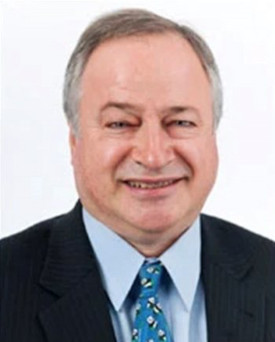
Alden Meyer is a Senior Associate at E3G working on US and international climate policy and politics. He is a Principal at Performance Partners, which provides a range of consulting services to clients in government, business, and the non-profit sector. (Photo: Courtesy of Alden Meyer)
MEYER: Well, it's not a perfect process, but it is the one place where the nations of the world and people of the world from all constituencies come together every year to reflect on how well we're doing and to try to figure out how we can do more to deal with the climate emergency. There really is no other venue. If we did not have this process, we'd have to reinvent it. The COPs and the negotiations are basically a mirror that we hold up to ourselves each year to reflect how we're doing as a species in dealing with this unprecedented emergency. And if the image that we see in the mirror appears a little ugly, it doesn't do a lot of good to blame the mirror. The problem is not the UNFCCC, the UN process, or the negotiations, there are ways to improve that, and some of those are being discussed. The problem is the lack of political will, in all too many countries, to make the tough decisions to protect people's lives. The problem is the dominance of the fossil fuel industry and other special interests in this process over the last 30 years, putting their short-term profit interests ahead of the well-being of their own people, and that's what we have to address. We need more profiles and political courage by leaders. We need more people stepping up to demand action, and most of that has to happen back in capitals and back in countries before delegations arrive at these COPs. What you see here is a reflection of the positions that have been negotiated and determined among the powerful countries before they send their negotiators to the COPs. And you can't just show up at a COP in Belém or Dubai or London or anywhere else, and expect to get instant change. You have to work hard for it in the months ahead at home, if you're going to affect the position of countries. And I think people are, are realizing that, and we're seeing some of that reflected in these hallways, but nowhere near enough.
BELTRAN: Alden Meyer is a Senior Associate at E3G, working on US and international climate policy and politics. Thanks so much for joining us.
MEYER: It was great to be with you again.
Related links:
- Delve into COP30
- Learn more about E3G, where Alden Meyer is a Senior Associate
- Listen to LOE’s story regarding Amazonian forest fires
[MUSIC: Omar Sosa, Seckou Keita, “Dary” on Transparent Water, Ota Records]
O’NEILL: If you enjoy the stories you hear on Living on Earth, please consider signing up for our newsletter. You'll never miss a show, and you'll have special access to show highlights, notes from our staff, and advanced information about upcoming events. The Living on Earth newsletter is sent to your inbox weekly. Don't miss out! Subscribe at the Living on Earth website, loe.org, that's loe.org. And by the way, you'll also find photos, links to more information, and a full transcript of every single show. And we'd love to hear from you. You can write to us anytime at comments@loe.org, That's comments@loe.org.
[MUSIC: Omar Sosa, Seckou Keita, “Dary” on Transparent Water, Ota Records]
O’NEILL: Just ahead, The symbiotic relationship between an Indigenous tribe in the Amazon and stingless bees. Stay tuned to Living on Earth.
ANNOUNCER: Support for Living on Earth comes from the estate of Rosamund Stone Zander - celebrated painter, environmentalist, and author of The Art of Possibility – who inspired others to see the profound interconnectedness of all living things, and to act with courage and creativity on behalf of our planet. Support also comes from Sailors for the Sea and Oceana. Helping boaters race clean, sail green and protect the seas they love. More information @sailorsforthesea.org.
[CUTAWAY MUSIC: Omar Sosa, Seckou Keita, “Dary” on Transparent Water, Ota Records]
Earth's Cryosphere On Thin Ice
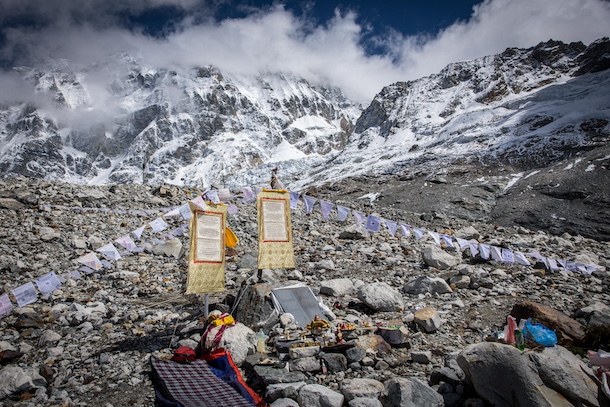
Two memorial plaques at the bottom of the Yala Glacier in the Langtang Valley of Nepal. The glacier has lost 66% of its mass and retreated nearly 800 meters since the 1970s. (Photo: The International Centre for Integrated Mountain Development (ICIMOD))
ONEILL: It’s Living on Earth, I’m Aynsley O’Neill.
BELTRAN: And I’m Paloma Beltran.
Scientists attending the 30th UN climate conference in Brazil are highlighting the alarming state of the cryosphere, or the frozen part of Earth covered in ice, snow, and permafrost. A recent report by the International Cryosphere Climate Initiative warns that “the European Alps, Rockies of the Western U.S. and Canada, Iceland, and Scandinavia would lose nearly all ice at 2°Celsius of warming.” And we’re on track for more than that at this point. Miriam Jackson is a glaciologist, climate scientist and the Eurasia and Nordic director of the International Cryosphere Climate Initiative. She’s there at COP30 and she joins me now. Welcome to Living on Earth, Miriam!
JACKSON: Thank you very much. Nice to be here.
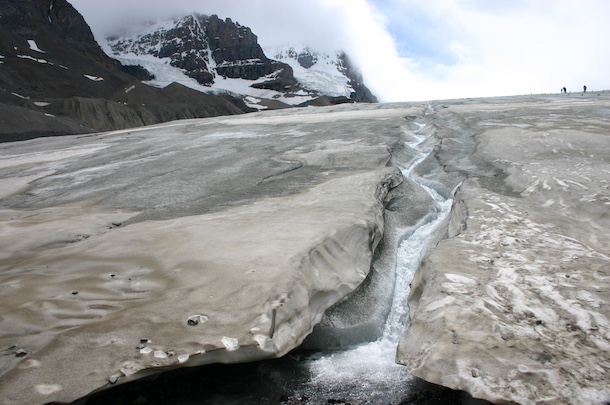
A river of melt-water running down the slope of a toe of the Athabasca Glacier in Jasper National Park, Alberta, Canada. (Photo: Wikimedia Commons, Wing-Chi Poon CC BY-SA 2.5)
BELTRAN: So what is the current state of the cryosphere right now? I know you just had a presentation at COP30, at the climate talks, about the cryosphere. What are we looking at here? Where does the cryosphere stand?
JACKSON: Very good question. So yes, I've actually just been given a presentation on tropical glaciers. The tropical glaciers are the ones that, you know, these low latitudes, in Peru, in Bolivia, in Ecuador, also in Africa. They're actually responding very quickly to climate change. They're at high elevation, and they're a little bit different than other glaciers, because they sort of get mass to get snow at any time of the year, and they can melt at anytime the year. And they're changing very quickly, probably, you know, more quickly than the global average. And we do see that globally, glaciers all over the world are changing fast, some areas faster than others. For example, the European Alps, the glaciers are changing very fast in parts of Norway, especially northern Norway, on Svalbard, up, you know, very high northerly latitudes. And it's actually quite interesting because it's a little bit unusual that when there has been climate change in the past, it's possibly a little bit different from one part of the world at the other. But what we're seeing now is something very similar over the whole world, that all the different glaciers, ones that, you know, very high latitudes, almost quite close to the North Pole. The ones at very high elevation, quite close to the equator, the ones in high mountain Asia a lot of these are generally 5000 meters and above. These are all changing. Some of them are changing quite slowly, and some of them are changing quite fast. But since the turn of the century, so since 2000, many of them have lost 20% of the mass, and some of them even more, and that's a huge amount, to use that much of the mass in just over 20 years. That's not sustainable. That kind of rates many glaciers are going to disappear very soon. Some glaciers have already disappeared. Venezuela, Slovenia lost their last glaciers quite recently. So this isn't something that we're saying this is going to happen. We should be careful. This is already happening.
Miriam Jackson giving a presentation on tropical glaciers at COP30 in Belem, Brazil. Photo: Miriam Jackson)
BELTRAN: What are some of the impacts of melting glaciers on surrounding communities and on the world as a whole?
JACKSON: We're seeing many different impacts from melting glaciers. The most immediate is people, especially in high mountain areas who use the water from melting glaciers for water supply. Hindu Kush, Himalaya, a lot of people there are very dependent on glaciers for melt water, for agriculture, for hydropower, also for tourism, also for spiritual reasons, glaciers means so much to so many people. And what we're seeing is that people are already being affected by glacier change now, and this is affecting monk communities the most, affecting them now. Also affecting a lot of people downstream who might live far from the glaciers, but especially in arid regions, you know, certain parts of Central Asia and northern Pakistan, it's very dry, but they depend on water from glaciers, also water from snow and they're really seeing changes now or their going to see them very soon. Also what we're seeing is that the glaciers are also it will affect the sea level because even though the mountain glaciers are small, they're already affecting how the water goes into the sea and causes sea level rise. And this affects everybody living in coastal communities, on low lying islands.
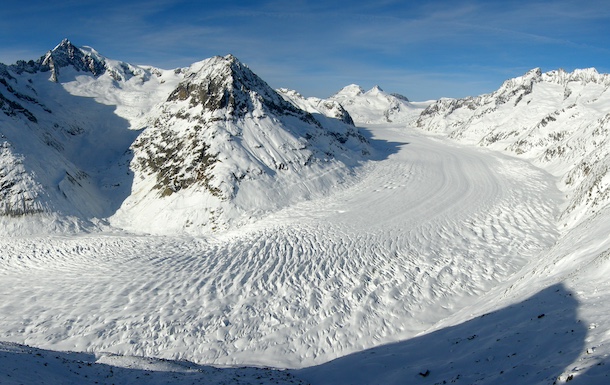
The largest and longest glacier of the Alps: the Aletsch Glacier seen from Eggishorn, Valais, Switzerland (Photo: Tobias Alt, Wikimedia Commons,CC BY-SA 4.0)
BELTRAN: And Miriam, what are glaciologists and cryosphere researchers pushing for at COP30?
JACKSON: We're here for a few different reasons. Basically we're trying to, you know, to communicate information about the cryosphere. You know, the things I've just told you that these are the different ways the changes in glaciers are still affecting us. It's changes in water supply, it's hazards like the floods, it's sea level rise. And just trying to make sure that the negotiators understand the science that they have, they have the facts, they have the language that they need. We're working hard to get it in the text, and sometimes we do see that people in some parts of the world are thinking like why are we interested in sea ice? This doesn't affect us. You know, we're not in the Arctic, sea ice doesn't affect us. Changes in sea ice affect everybody, because this affects the albedo of the earth. As we lose sea ice, the earth gets warmer even faster. So we're trying to communicate this, that these are the facts about cryosphere, this is how fast it’s changing, this is how much the change is accelerating, and making sure that the policy makers here, the negotiators here, understand this, and they have the language also and the knowledge, so they can get this into the text, and we’ll if necessary, fight to keep it in the text, because there's always a lot of discussion on what should and shouldn't be in the text.
The Artesena glacier in Ecuador taken by Miriam Jackson during a field trip before an IPPC lead author meeting in February 2018. (Photo: Miriam Jackson)
BELTRAN: And you're currently at COP30 in Belém, Brazil, where these climate negotiations are taking place. It's been 30 years of climate negotiations. What are the sentiments there?
JACKSON: Well, the sentiments here vary quite a lot. There's many countries, you know, there's countries like Tajikistan like Nepal, like Bhutan, that are really seeing the effects now of changes in the glaciers. They might have seen deaths from these glacially outburst floods, or they might just be seeing other floods that are caused by, you know, sudden rain on the snow and they're seeing all kinds of changes, so they're very concerned.
Miriam Jackson is a glaciologist, climate scientist, the Eurasia and Nordic director of ICCI (International Cryosphere Climate Initiative) and the research scientist for the Norwegian Government at the Norwegian water sources and energy directorate. (Photo: Miriam Jackson)
And the low lying island states, you know, they have a coalition, and they're very concerned as well, because, as they say, they've contributed the least to climate change but they're some of the ones who are suffering the most, and some of these islands are very low-lying, and they're thinking, will we even still be here by the end of the century? So they really feel the urgency. There's also a lot of countries here who export oil, and burning hydrocarbons is one of the main reasons for climate change, and a lot of them are quite reluctant to see the urgency. Obviously, their countries make a lot of money from exporting oil, so they want to keep on. And I think, to be honest, I think they don't really understand that this is something that’s going to affect everyone. There's no point in continuing to make money if the whole world is struggling so much with climate change that nobody's interested in buying oil anymore, they're just interested in survival. So it is frustrating here, and for some people, this is existential. Just because of disruptions globally, we have disruptions in trade as we have more people migrating because where they live, they can no longer live, they can no longer survive. So globally, it's going to affect everybody. And it's it is very hard trying to communicate this to some of the countries who possibly aren't immediately affected, but will be in the long run. But we keep on trying.
BELTRAN: Miriam Jackson is a glaciologist, climate scientist, and the Eurasia and Nordic director of the International Cryosphere Climate Initiative. Thanks so much for joining us.
JACKSON: Thanks very much. It's been a pleasure talking to you.
Related link:
Learn more about the International Cryosphere Climate initiative
[MUSIC: Death Cab for Cutie, “The Ice Is Getting Thinner” on Narrow Stairs, Atlantic Recording Corporation for the United States and WEA International Inc. for the world outside of the United States]
Rights of Nature for Stingless Bees
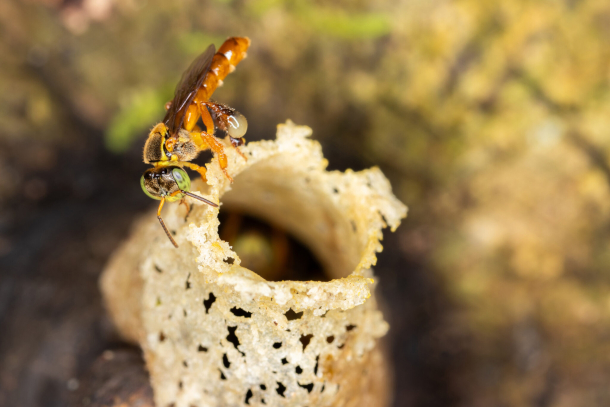
Tetragonisca angustula, also known to locals as “angelitas”, or “little angels”. Here, a worker bee perches at the entrance of a wild nest. (Photo: Kathryn Naherny)
O’NEILL: Most of us are familiar with a few key facts about honeybees; they live in hives, they pollinate our food, and they sting. But hundreds of honeybee species don’t actually have that stinger we know from European honeybees, though they do still live in hives and pollinate crops. One of the places you can find these stingless bees is in the Peruvian Amazon, where the local Asháninka people have developed a sort of symbiotic relationship with the bees and their honey. But habitat loss linked to climate change, forest fires, and deforestation is posing an existential threat to these bees and indigenous communities. Teresa Tomassoni of our media partner Inside Climate News reported on a new, first-of-its-kind Peruvian law that gives these stingless bees legal rights to help protect them. She’s here to give us the buzz—Teresa, welcome to Living on Earth!
TOMASSONI: Thank you so much for having me.
O'NEILL: Teresa, tell us: what is a stingless bee? What sets these bees apart from the ones that we might be familiar with here in the United States?
TOMASSONI: Stingless bees, as the name suggests, either don't have stingers or have stingers that lack the ability to cause pain. Now that doesn't mean that they can't cause a little bit of harm now and then by biting. For the most part, these bees are very sweet and gentle, as the Asháninka people taught me. That's why they call one of the species angelitas, which means little angels. These stingless bees are key pollinators in the Amazonian ecosystems. They are contributing to the pollinization of at least 75% of agricultural crops in the region. One of the reasons that stingless bees are so not well known is they're tiny. They are often dismissed as flies or wasps. People don't know the major role that they play in pollinating the Amazon rainforest, the lungs of the world.

Some of the local indigenous communities in the Peruvian Amazon region sell stingless bee honey, which has been a part of their cultural medicinal practices for millenia. Two of the Peruvian scientists that Teresa Tomassoni interviewed, Rosa Vásquez Espinoza and Cesar Delgado, have found molecules in some of this honey with a number of medicinal properties, such as antibacterial, antifungal, and anti-inflammatory. (Photo: Teresa Tomassoni, Inside Climate News)
O'NEILL: And you were on the ground in Peru for about two weeks reporting on these bees. Can you tell us a little bit about that experience? You know, what's it like in that region of Peru? And who were some of the people that you actually spoke to there?
TOMASSONI: It was such an incredible experience. You know, I've been to the Amazon various times, but I've always been close to the Amazon River. We were actually in the central Peruvian Amazon. So we were in a region that's higher altitude. We were climbing up steep mountain paths, taking a moment to catch our breath as we're hiking uphill. The first time I saw the stingless bees happened in the Indigenous Asháninka community of Pichiquía, located along the Ene river. Doctora Rosa Espinoza, another entomologist who's Peruvian and Indigenous as well, César Delgado and some of the other Asháninka community members who have been practicing stingless beekeeping, which is called meliponiculture, arranged to facilitate a workshop in the community center where they showed off two bee boxes, which they called cajas in Spanish. And when I watched Doctora Rosa Espinoza and another woman featured in my article, Micaela Huaman, open that first hive, I was just amazed, because this hive looked very different from the honeycomb hives many of us have seen. This hive looked like a soccer ball riddled with kind of craters, almost like a planet. It was very globular and had these cavities. And what is super interesting is these stingless bees create these grape sized honey pods where they put their honey in, and that's where the honey is stored.
O'NEILL: And well, of course, I have to hear even more about this honey. I'm hoping you had a taste test that you can maybe share with us. What did you learn about this honey?
TOMASSONI: This honey is not like any honey that you would buy in a store, at least in the United States, right? This honey has a high water content. It's a little bit sour or acidic. Some of it is sweet. It's both sweet and sour. It goes down very easily. It doesn't stick to the back of your throat. It's not gooey. It goes down almost like a spoonful of medicine. And in fact, it is highly medicinal, which Indigenous people, the Indigenous Asháninka and other Indigenous groups throughout the Amazon have known for millennia. They've used it to treat a wide array of illnesses, and now scientists like Doctora Rosa Espinoza and César Delgado are just confirming that in their laboratories by doing these chemical analyses of these honeys and finding that they have anti-inflammatory, anti-bacterial, even anti-viral properties.
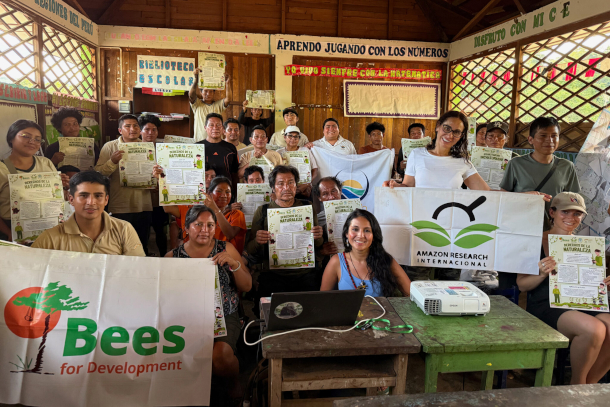
In 2025, Dr. Rosa Vásquez Espinoza, along with members of Amazon Research International and Earth Law Center, held a number of workshops on the Rights of Nature, particularly on their efforts to have the Peruvian government declare rights for stingless bees in the Amazon, alongside the Asháninka community. (Photo: Teresa Tomassoni, Inside Climate News)
O'NEILL: So, Teresa, tell us about the process of stingless beekeeping. How does it work exactly?
TOMASSONI: First you have to find the bees. Even in the best of conditions, it's not easy to find them. Their nests are not just hanging from trees. They're hidden inside the trees. They're hidden inside rotten logs. Some Indigenous peoples like this park ranger, Richar, listens for the bees. He can stand still in the forest and attune his ear into the sound of stingless bees, which I find quite incredible, and then follow that sound to the nest. But to access the nest even once you know where it is, is not easy. What I'm told is that historically, these nests were removed from a tree by chopping the entire tree down, which, as you can imagine, is not the most sustainable thing to do in the Amazon rainforest when we're trying to preserve habitat. And so the Asháninka people have developed a new method of basically cutting out a small section in the tree in a way that doesn't harm the tree permanently. They can detect where the nest is basically by knocking on the tree, again by sound. Once that nest is put into the bee box, they leave that box near the tree to, with the hopes that they're going to attract the bees back. They're going to then find this box with a little bit of honey around its entrance, and hope is that they enter and begin working in their hive once again. Once they see that the bees are thriving in that bee box, usually about a week after they've been removed from their natural habitat, they'll move that box to another area, either into a community or near a garden plot that they want more pollinators in.
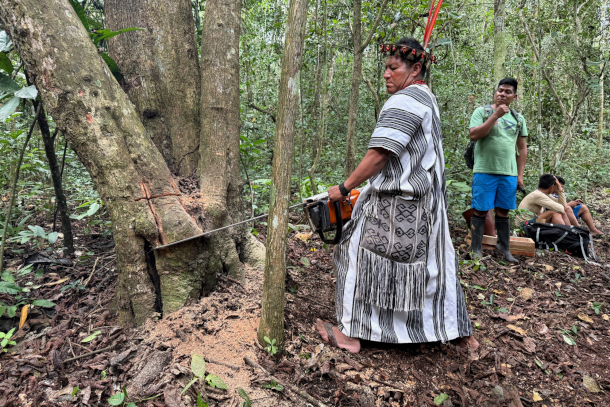
Asháninka leader, César Ramos shows onlookers how to sustainably remove a wild stingless bee nest without fully cutting down the tree housing it. In the modern age, the Asháninka people and other local communities are cultivating stingless bees in wooden bee boxes, helping to multiply the hives and repopulate the species. (Photo: Teresa Tomassoni, Inside Climate News)
O'NEILL: And what about the role that they play in local culture? How do stingless bees, and I guess stingless beekeeping, fit into the local Indigenous communities?
TOMASSONI: The Asháninka people have a very strong relationship with the stingless bees. They call them their ancestors. They say we live with the bees. The bees live with us. And so for thousands of years, they say their ancestors have relied on the bees to provide honey that helps them treat a variety of illnesses. The Indigenous peoples really credit the stingless bees for helping them survive.
TOMASSONI: So your reporting talks about a new declaration that came out of the Peruvian government that actually gives these bees legal rights. Now, for those of us who might not know why this is, how would you explain what it means for an insect to be granted legal rights like this?
TOMASSONI: So before last year, the Peruvian government didn't even acknowledge that stingless bees existed as a species within their country. They had no legal protections whatsoever, even though European honeybees, apis mellifera, did. So, what Doctora Rosa Espinoza, Earth Law Center, other scientists in the Asháninka people really advocated for was first a national law that recognized these bees exist in our country, but then they wanted to strengthen that law to go a step further by acknowledging these insects as inherent holders of legal rights. And so this next step is based on a growing “rights of nature” movement, which is a legal and philosophical framework that is really meant to strengthen and reframe how we protect the environment. And so this new declaration actually was developed in collaboration with Asháninka leaders and community members. It also mentions that the indigenous people's rights are inextricably connected with those of the stingless bees. They acknowledge that the indigenous people's culture, their spiritual beliefs, are very much intertwined with the well-being of the stingless bees.
O'NEILL: And what kind of threats are they facing that really inspired this push to protect them?
TOMASSONI: As we know throughout the Amazon, deforestation is one of the number one threats to habitat and species. We are seeing illegal logging happening rampantly throughout the Amazon, but particularly in this region of Junín. We're seeing large areas of land clearing happening to make way for other agriculture, cattle grazing, even illicit coca crops, so their habitat is being largely wiped out. And then we have climate change, which is raising temperatures in these typically cooler environments, as I mentioned, in this part of the Amazon, forcing the bees to move higher, further away from communities that are used to depending on them, and harvesting their honey for medicine, for example.
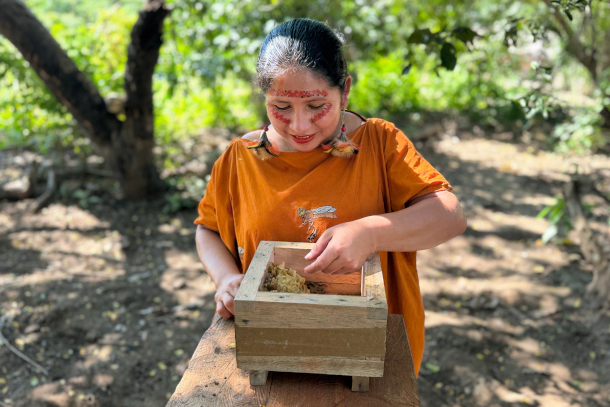
Asháninka stingless beekeeper Micaela Huaman Fernandez inspects a hive of Tetragonisca angustula bees. (Photo: Teresa Tomassoni, Inside Climate News)
O'NEILL: And so what kind of impact do you see these new legal rights having, not just on the bees themselves, but in the local culture?
TOMASSONI: What I'm hearing from Rosa Espinoza, for example, is that the government of Satipo will implement this local law by designating or funneling funds to local communities to be trained in meliponiculture, in the practice of stingless beekeeping. But the sources of income are very limited in this region, and so by training them in stingless beekeeping, by giving them the materials, could open up a whole new opportunity for earning income in this particular area. We're already seeing this happen in other regions of the Peruvian Amazon. The other part of this implementation is very much focused on restoration. So the scientists, the Asháninka leaders, are really hoping that investments will be made in restoring areas that have been degraded by illegal logging, by wildfires.
O'NEILL: Well, so Teresa, some might say, okay, cool, fun facts we now know that a stingless bee exists, but what's the impact here? What's the importance here? Why would you say that people globally should care about these stingless bees?
TOMASSONI: I think it's important to note that we are facing a global crisis in losing our pollinators, from our butterflies to our honeybees to the stingless bees in the Peruvian Amazon. Losing our pollinators affects us all. This affects the agricultural crops that we depend on for our food. It affects the availability of medicinal plants, and so the stingless bee is a unique case study in which to set our eyes on and learn from and acknowledge what can happen when their habitat disappears. When it's cleared, those pollinators disappear, and then what happens? We lose those medicinal plants. We lose the potential to pollinate the crops that large populations also depend on throughout the region.
O'NEILL: Teresa Tomassoni is a journalist with Inside Climate News. Teresa, thank you so much for joining me today.
TOMASSONI: Thank you so much for having me.
Related links:
- Inside Climate News | “Defending Stingless Bees in the Peruvian Amazon”
- Dr. Espinoza’s website
- Amazon Research International
[MUSIC: London Symphony Orchestra. “The Flight Of The Bumble Bee” on Classical Favourites – An Hour Of The World’s Best Loved Music, V & H Holdings Pty Ltd]
O’NEILL: Living on Earth is produced by the World Media Foundation. Our crew includes Naomi Arenberg, Sophie Bokor, Jenni Doering, Daniela Faria, Swayam Gagneja, Mark Kausch, Mark Seth Lender, Don Lyman, Ashanti Mclean, Nana Mohammed, Sophia Pandelidis, Jade Poli, Jake Rego, Andrew Skerritt, Bella Smith, Melba Torres, and El Wilson.
BELTRAN: Tom Tiger engineered our show. Alison Lirish Dean composed our themes. You can hear us anytime at loe.org, Apple Podcasts and YouTube Music, and like us please, on our Facebook page, Living on Earth. Find us on Instagram @livingonearthradio, and we always welcome your feedback at comments@loe.org. Steve Curwood is our Executive Producer. I’m Paloma Beltran.
O’NEILL: And I’m Aynsley O’Neill. Thanks for listening!
ANNOUNCER: Funding for Living on Earth comes from you, our listeners, and from the University of Massachusetts, Boston, in association with its School for the Environment, developing the next generation of environmental leaders. And from the Grantham Foundation for the protection of the environment, supporting strategic communications and collaboration in solving the world’s most pressing environmental problems.
ANNOUNCER 2: PRX.
Living on Earth wants to hear from you!
Living on Earth
62 Calef Highway, Suite 212
Lee, NH 03861
Telephone: 617-287-4121
E-mail: comments@loe.org
Newsletter [Click here]
Donate to Living on Earth!
Living on Earth is an independent media program and relies entirely on contributions from listeners and institutions supporting public service. Please donate now to preserve an independent environmental voice.
NewsletterLiving on Earth offers a weekly delivery of the show's rundown to your mailbox. Sign up for our newsletter today!
 Sailors For The Sea: Be the change you want to sea.
Sailors For The Sea: Be the change you want to sea.
 The Grantham Foundation for the Protection of the Environment: Committed to protecting and improving the health of the global environment.
The Grantham Foundation for the Protection of the Environment: Committed to protecting and improving the health of the global environment.
 Contribute to Living on Earth and receive, as our gift to you, an archival print of one of Mark Seth Lender's extraordinary wildlife photographs. Follow the link to see Mark's current collection of photographs.
Contribute to Living on Earth and receive, as our gift to you, an archival print of one of Mark Seth Lender's extraordinary wildlife photographs. Follow the link to see Mark's current collection of photographs.
 Buy a signed copy of Mark Seth Lender's book Smeagull the Seagull & support Living on Earth
Buy a signed copy of Mark Seth Lender's book Smeagull the Seagull & support Living on Earth

